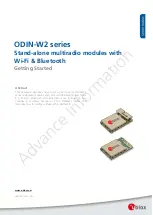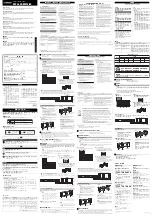
ODIN-W2 series - Getting Started
UBX-15017452 - R02
Advance Information
Bluetooth configuration
Page 12 of 27
5
Bluetooth configuration
You can configure the ODIN-W2 module according to specific customer requirements using AT commands (see
ODIN-W2 AT Commands Manual [1]
). The easiest way to get started is to use the s-center, which is a graphical
user interface for sending AT-commands (see
s-center Quick Start Guide [4]
). The s-center allows for easy
configuration with the most common AT commands.
5.1
Basic settings
There are some basic commands for controlling the general Bluetooth behavior of the module.
•
Connectable (AT+UBTCM):
Shall other devices be able to connect to the module? This does not affect
outgoing connections.
•
Discoverable (AT+UBTDM):
Shall the module be visible to remote devices making inquires?
•
Pairable (AT+UBTPM):
Shall another device be able to pair (authenticate) with the module?
•
Bluetooth name (AT+UBTLN):
The name found by remote devices making inquires.
•
Class of device (AT+UBTLC):
Classification of what kind of device the module is. There are standard
settings according to the Bluetooth specification.
If a module has been configured to connect or accept an incoming connection to/from a remote device and if
pairing is done (needed only once), it is a good idea to disable both discoverable and pairable devices for security
reasons and performance.
5.2
Client and Server
A client will initiate a connection and the server will accept an incoming connection.
Figure 7 Client connecting to the server
The client and server role is often mistaken for master and slave role. The master/slave role is defined at a lower
level (master polls slave at radio level) and has nothing to do with client and server. By default, the client will
become master and the server will become slave. However, a master/slave switch during or after connection set-
up can change this. The master/slave role is to be considered for the multipoint case only (see Multipoint
section).
To configure a client to automatically set up a connection to a server, configure the correct Bluetooth profile and
the remote peer. The Bluetooth profile controls the type of connection that is requested (see Bluetooth profiles
section) and the remote peer defines what server the client shall connect to. For more than one connection, see
the Multipoint section.
•
Default Remote Peer (AT+UDDRP):
Configures what server (profile and address) to connect to and
when to initiate the connection. Peer enumeration starts with id 0 and continues with id 1 and so on.
To configure the server, consider only the Bluetooth profile and a module is configured as a Serial Port Profile
(SPP) server by default.
•
Server Configuration (AT+UDSC):
Will only accept incoming connection attempts for the configured
server profile. Some profiles can be configured in parallel.













































